PinotFile: 6.6 November 27, 2006
|
Radio-Coteau: Rare & SpecialRadio-Coteau is deservedly a true “cult” Pinot Noir. A “cult” wine is one produced in very small quantities by a very skilled and experienced winegrower and winemaker, sold and tightly allocated through a mailing list, distinguished by unique and special wines, and known only to the most dedicated wine geeks.. 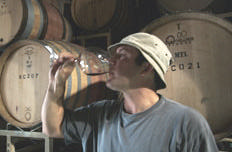 Owner Eric Sussman developed an interest in wine while studying agriculture at Cornell University in Ithaca, New York. He ventured to Washington’s Yakima Valley where he spent several years managing the vines and cellar of a small artisan producer. He then moved on to France and spent the 1995 vintage in Burgundy at Comte Armand in Pommard and Domaine Jacques Prieur in Meursault. After returning to northern California, he worked one year at Bonny Doon and from 1988-2001 as the associate winemaker at Dehlinger. He crossed paths with Bill and Joan Smith, former owners of La Jota, and current owners of W.H. Smith Wines. They formed a partnership that became Radio-Coteau Wine Cellars. “Radio-coteau” are two conjoined words derived from the northern Rhone region of France. The colloquial meaning is “word of mouth,” but the literal translation is “broadcasting from the hillside.” Eric first heard this expression from a friend while living and working in Burgundy. It refers to a commitment to community, to growers found by word of mouth, tradition handed down in the cellar, and friends helping at harvest. The inaugural Pinot Noir releases in 2002 focused on vineyards in the true Sonoma Coast and Savoy Vineyard in the Anderson Valley. The wines were received by the wine press with considerable praise and quickly sold out. Andy Tan, noted sommelier and wine retailer said, “This estate is making the most exciting Pinot Noir from California.” After tasting through the 2003 lineup (PinotFile, Volume 4, Issue 44) I noted that all of the wines were superb: “A lot of Pinot and ton of Noir.” I recently tasted through the 2004 lineup of Pinot Noirs which were released in March, 2006. Once again, I came away very impressed by the complex array of flavors, the voluptuous textures, and the sensuality of the wines.
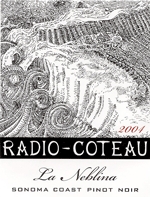 2004 Radio-Coteau La Neblina Sonoma Coast Pinot Noir 14.4% alc., 760 cases, $40. This wine is named for the fog (“La Neblina” is Spanish for fog) that is ever present in the cool vineyards of the western Sonoma Coast. A blend of grapes sourced from two vineyards along the Sonoma Coast (growers Kirk Lokka and Bill Smith), the clones are Dijon 115 and 777. · I love the aromatics featuring perfectly ripe Pinot fruits. There is a panoply of wonderful flavors including black cherry, cassis, mushrooms, spice, smoke and earth. This is the most structured of the three wines, yet light as a feather. A warm fuzzy mouth feel leads to a finish that is long and pure.
2004 Radio-Coteau Albirigi Vineyard Russian River Valley Pinot Noir 14.4% alc., 150 cases, $42 (sold out). The Alberigi Vineyard sits on Vine Hill Road in the Russian River Valley. The vines here were planted in 2001 (Dijon 114, 115, 777) and thrive on the Goldridge soil . This is the debut bottling from a vineyard sourced exclusively by Radio-Coteau. · This beauty has that Williams Selyem Rochioli nose that I am continually searching for - spicy Bing cherries, Dr Pepper, cola, and a touch of rhubarb. The flavors continue the theme and are light as an angel. Beautifully balanced. This wine does it “nice and easy.”
2004 Radio-Coteau Savoy Vineyard Anderson Valley Pinot Noir 14.4% alc., 480 cases, $48 This prestigious vineyard farmed by Richard Savoy is the source for many notable California Pinot Noirs (Adrian Fog, Barnett, Littorai, and Roessler). This hillside vineyard is located in a cool, yet sunny site northwest of Philo and has a multiple range of clones, exposures and soils. The vineyard was planted in 1992 and 1996. This bottling contains Pommard, Dijon 115, and Martini clone. · This wine has very nice soft red Pinot fruits on the nose and on the palate accentuated by floral and spice elements. The sweet fruit flavors linger on the finish. The whole package is nicely balanced.
2004 Radio-Coteau Terra Neuma Sonoma Coast Pinor Noir 74 cases, $48 (sold out). This is also a debut-bottling from a hillside vineyard farmed biodynamically by the Benzigers. The vineyard is southwest of Freestone, a few miles inland from the Pacific ocean. It was planted in 2002 to Dijon clones 115 and 777. I did not receive any allocation of this limited-production wine so I cannot provide any tasting notes.
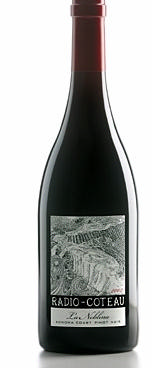 2003 Radio-Coteau Hellenthal Vineyard Sonoma Coast Pinot Noir 14.6% alc., 100 cases. · Tasted last year, this was a bruiser that needed a lot of air time. Now it is flat-out terrific. The aromatics are rich with dark cherries, dark plum, rhubarb, tea and oak. Beautiful dark Pinot fruits with earthy undertones which are mouth-coating. With air time the wine becomes as soft as a Pinot Noir marshmallow. I would match this against any Burgundy any time. One of the best Pinot Noirs I have drank this year and the stuff that Pinot dreams are made of.
Radio-Coteau is a virtual winery with an excellent website: www.radiocoteau.com. There is a mailing list signup on the website, but at this point, do not be disappointed by very limited allocations. The W.H. Smith Wines 2005 Pinot Noirs have just been released. There are two wines: 2005 W.H. Smith Wines Sonoma Coast Pinot Noir ($28) and 2005 W.H. Smith Wines Maritime Ridge Sonoma Coast Pinot Noir $52. The Smith’s first vintage of W.H. Smith Wines was 1992. In 1994, they purchased 260 acres above the town of Cazadero on the Sonoma Coast. The first vintage of Maritime Ridge Vineyard from this property was 2002. The wines from this vineyard have been rich, plush and complex and highly touted by the wine press. I recently drank the 2003 W.H. Smith Wines Maritime Ridge Sonoma Coast Pinot Noir. A superb wine with ripe fruit aromas, a velveteen texture, coating tannins, and a long and intense finish. The wines are sold to a mailing list in six bottle increments only. The website is www.whsmithwines.com and the phone is 707-965-9726.
WoodenheadMy reverence for Burt Williams and Ed Selyem have led me to many spin offs such as WesMar, Brogan Cellars and Papapietro Perry who have achieved distinction with Pinot Noir on their own. Nikolai Stez owes his inspiration to Williams Selyem as well. He worked 17 harvests at Williams Selyem, and as an assistant winemaker for Burt Williams, learned from the master. 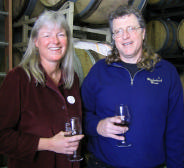 Growing up on the Russian River, Nikolai was drawn to wine at an early age and began some home winemaking while still in college. He began to seriously make garage wines in 1986 and mentored at Williams Selyem. With the sale of Williams Selyem Winery in 1997, he moved on and started his own label, Woodenhead Vintners. He still has a day job, but passionately devotes all of his free time to his Woodenhead project. His domestic partner, Zina Bower, is equally passionate about wine, and is involved as well, handling the marketing and business side of Woodenhead. She also has a day job as business manager at Diamond Creek Vineyards in Napa Valley. Winemaking here is “Burgundian done in the California style.” There is no pumping, hand punchdowns are employed, a gentle basket press is used, and aging is in French oak. Through his years of contacts in the Russian River Valley, Nikolai has been able to source fruit from some outstanding Pinot Noir vineyards. When you look back on the early success of Williams Selyem, one key that stands out was the quality of the vineyards from which the wines were made. You simply can’t make great wine unless you have exceptional grapes. The Woodenhead wines I tasted recently are proof of that tenant. On his website, Nikolai writes about the frustration he has experienced in trying to get Wine Spectator and/or Steve Tanzer to score his wines. Sorry, Nikolai, no scores from me either.
 2004 Woodenhead Russian River Valley Pinot Noir 14.8% alc., 273 cases, $36. This wine is a combination of several vineyards, including Buena Tierra. · This medium-bodied Pinot has restrained but promising aromas of cherry, wet earth and Christmas spice. Burgundy-oriented pinotphiles, would be attracted to this understated wine which displays subtle flavors of cherry, clove, spice and oak with a generous acid backbone and dusty tannins on the finish.
2004 Woodenhead Morning Dew Ranch Vineyard Anderson Valley Pinot Noir 14.5% alc., 166 cases, $46. After selling Williams Selyem and retiring, Burt Williams planted his own vineyard in the Anderson Valley. He is prevented from making wine himself because of a non-compete agreement, but probably prefers not too, simply relishing in nurturing a young vineyard to excellence. Two other producers are allocated grapes from Morning Dew Ranch - Whitcraft in Santa Barbara County and Brogan Cellars in Healdsburg. · This is a prodigious wine that is as dark as Pinot gets. With coaxing, a rich nose of dark fruits, brown spice and pepper emerges. The wine is dense and chewy on the palate with oak and earth notes preempting the fruit. The finish is mildly tannic with lively acidity. It is very tight and concentrated at this point and I recommend decanting, or preferably, cellaring for a period.
2004 Woodenhead Buena Tierra Vineyard Original Planting Russian River Valley Pinot Noir 14.8% alc., 193 cases, $46. This 26-year-old vineyard is “the bomb.” · This Pinot is the closest of the three to the early Williams Selyem style and is flat-out terrific. It is light in color and elegant in style. The nose-grabbing aromatics feature cherry pie and Asian spices with a hint of alcohol. The mouth feel is luxurious and the lingering finish leaves dreamy memories of spiced cherries which last until the next sip. Beautifully balanced. You will need a cold soak after drinking this one.
Also released, but not tasted:
2004 Woodenhead Wiley Vineyard Anderson Valley Pinot Noir 305 cases, $46. The Pinot Noir grapes for this wine come from 24-year-old vines, Pommard (5) and Martin Ray (37). It is one of the Anderson Valley’s heritage vineyards, the fourth planted after Edmeades, Husch and Van Hoorn. This vineyard is the closest to the ocean of any valley floor vineyard resulting in a very long growing season.
2004 Woodenhead Humboldt County Pinot Noir 112 cases, $32. Although Humboldt County is more well-known for an illegal mood-altering substance, there are several microclimates here that are ideal for Pinot Noir. One other producer from this region that stands out is Whitethorn.
Woodenhead: PO Box 1448, Forestville, CA 95436. The phone is 707-887-2703 (best time to call is Friday or Saturday). Wines may be ordered from the website: www.woodenheadwine.com.
Salud: Oregon’s Pinot Noir AuctionThe 15th Annual Salud Pinot Noir Auction in Oregon, was held November 11 and 12, 2006. The event raised a record $752,695, with $166,400 coming from the barrel auction of unique Pinot Noirs. 42 of Oregon’s top wine producers provided barrel samples of the 2005 vintage for the fundraiser. The majority of the 168 case lots went for more than $1,000, with several topping $2,000. Auction events included a tasting on Saturday at Domaine Drouhin and a dinner on Sunday at the Governor Hotel in Portland. The co-chairs of the event were Danielle Andrus Montalieu of Solena Cellars and Adam Campbell of Elk Cove Vineyards. Oregon vintners are passionate about Salud which provides healthcare outreach services for seasonal vineyard workers and their families. Salud is a bi-lingual, bi-cultural service involving a dedicated group of Oregon vintners and volunteers associated with Tuality Healthcare Foundation. “Salud” refers to the traditional Spanish toast, “to your health.” In 2005, Salud served over 3,000 qualified individuals. The 2007 auction will be held on Friday and Saturday, November 10 and 11. For more information, visit www.saludauction.org.
Grand Harvest AwardsThe Grand Harvest Awards International Wine Competition is open for registration. The 2007 Grand Harvest Awards takes place February 21-23 at the Fountain Grove Inn, Santa Rosa, California. Results will be published in Vineyard & Winery Management. The deadline for entries is January 19. Register online at www.vwm-online.com or phone 800-535-5670 x106. The Grand Harvest Awards is the only North American Wine competition that presents wine entries to judges according to regional classification. Wines of particular appellations are arranged in flights and tasted by judges selected for their knowledge of regional characteristics. After scoring, judges seek to identify the distinctive elements of terroir and its link to regional typicity.
Pinot Noir ShootoutSubmissions of Pinot Noir for the 5th Annual Pinot Noir Shootout are now being accepted up until December 15, 2006. The Pinot Noir Shootout is unique in that each of the wines is more intensely judged than in standard, broad competitions. Most competitions go straight to medals, but the Pinot Noir Shootout provides concerted, then condensed reviews, providing thorough, quotable, consumerfriendly, and accessible results from a varied panel of experts. Male and female reviews are kept separate and posted on the Affairs of the Vine website at www.affairsofthevine.com. The judging panel is comprised of a diverse group of over 40 wine professionals with a bent for Pinot Noir. Last year I served on the tasting panel and was impressed by the experience and passion of the judging panel. Considerable time is spent judging each wine over a generous scoring period so that each wine receives the attention it deserves. All judging is blind. I plan to taste on the panel again this year. The top 40 wines and their winemakers are presented along with seminars at the Pinot Noir Summit in San Francisco on February 10, 2007. Consumers who attend the Summit are asked to judge the final 40 Pinot Noirs from their perspective as well. Vintners must submit four bottles of each entry along with a $60 registration fee ($50 online at www.affairsofthevine.com. The wines should be sent to Affairs of the Vine, 696 Elliott Lane, Sebastopol, CA 95472 (707-874-1975).
Tasting Room TravailsI am often asked to refer readers to wineries to visit. Generally, the most rewarding experiences come from scheduled appointments with the owner and or winemaker. However, in some instances the consumer ends up in the tasting room expecting at least some modicum of friendliness and attention. One of my readers had a very unfortunate experience recently and I thought I should relate the story. In a recent issue of the PinotFile I wrote an article about the Babcocks, their excellent wines, and their restaurant in Seal Beach called Walt’s Wharf. I have referred pinotphiles who are visiting Santa Rita Hills to Babcock Winery based on the high quality of the wines. Unfortunately, I am afraid that the movie Sideways has overwhelmed some Santa Barbara wineries like Babcock, brought them added success and notoriety, and the personal touch has been lost. My friend wanted to visit over Thanksgiving weekend, but when he called several weeks ahead, he was discouraged from coming as “we are too busy with visitors then.” Despite this, he decided to give them the benefit of the doubt and drop in. They had none of their Pinot Noirs for tasting or for individual sale in their tasting room. I had told him to inquire about the 2004 Babcock Mt. Carmel Pinot Noir since I had drank it recently at Walt’s Wharf and found it to be quite good. He was told that “they don’t make it anymore because the grapes didn’t stand up their standard of excellence!” My friend felt “they were full of themselves.” The good news is that the other wineries he visited were more than accommodating: Melville, Fiddlehead Cellars, and Ken Brown Wines. I liked Ken Brown’s comment when asked if his tasting room was considered the “ghetto,” Ken shares space with Ampelos Cellars in a Lompoc industrial park apart from the Lompoc “wine ghetto” on Industrial Way, and he said, “No, but it’s close to the prison. Some call us the Pinot Prison, but I prefer Pinot West!”
Domaine De La Romanée-Conti - Vintage 2006Aubert de Villaine wrote a summary of the 2006 harvest at Domaine de la Romanée Conti and through the courtesy of Wilson Daniels, the exclusive United States importer, I was able to obtain a copy. I think this is of great interest to all lovers of Burgundy and I would like to reprint a portion of it here. The report from the Domaine was written on October 19, 2006. At the time of this writing, the vineyards, emptied of their fruit, had begun to change color. The villages were quiet again after the hubbub of harvest. The streets were filled with generous fragrances coming from the wineries where fermentations were proceeding. The birth of this new vintage is always a real pleasure to the senses. The climatic conditions in 2006 were a little crazy and, at first, a great source of anguish before restoring, against all expectations, our optimism and confidence. In brief, what we experienced: * A long, unusual heat wave in July that stopped the vegetative cycle of some vines. Although most of them displayed an amazing ability to withstand the stress. * The coolest and rainiest August since 1986, favorable to botrytis that set in very early. * After the unpredictable extremes of heat, cold and humidity, one decisive factor appeared that brought the vintage to a happy end: hot weather, without any rain, that lasted for the entire month of September (except for a stormy couple of days on the 23rd and 24th). These ideal conditions permitted the vineyards to efficiently use the water retained in the soil from the rain in August, therefore allowing the ripening process to accelerate greatly. In September, the sugar levels increased by almost 2 degrees per week at times, especially during the third week. The harvested grapes were as ripe as in 2005. Botrytis reappeared during harvest on the stormy day of September 24. Luckily, it was too late in the season, and the episode was too short to cause damage. Although the year was difficult, it gave the vigneron the opportunity to make great wines, as long as he or she had used the right means to harvest ripe grapes before the botrytis did too much harm first, Controlling yields was essential. The fine “Pinot Noir fin” that bears small clusters with small berries showed how its predominant presence is important in our vineyards, although it was still necessary to thin the young vines at the time of veraison. In such climatic conditions, only low yields could first allow the vines to fight the heat and later the attacks of botrytis, then to mature early - something that was necessary to allow us to harvest before the rain returned. An ultra-meticulous sorting was crucial in order to eliminate the botrytised grapes. In the winery, Bernard Noblet’s team performed “haute couture” selection on the sorting table and put the finishing touches to the pickers’ work. To summarize, the conditions were difficult in the beginning of the season, but excellent by the end, giving us the opportunity to bring in ripe, sugar-rich grapes. We feel as though we adjusted everything as precisely as was possible. We harvested in the following order: Richebourg, La Tache, Romanee-Conti, Romanee-St.-Vivant, Grands-Echezeaux, Echezeaux. The yields of the red wines did not exceed 28 hl/ha. The Montrachet was harvested near the end of the season on September 26. The low yields and the ripeness of the Chardonnay grapes, gold and juicy, full of sugar and slightly botrytised - just what is needed - should give a great 2006 Montrachet. The beginning of the fermentations were rapid and spontaneous, the vinifications proceeded without any difficulty. The vatting lasted, as usual, around 18 days. It is too early to give a definitive opinion about the quality of the 2006 vintage, but the first wines seem to meet our expectations.
Gundlach Bundschu: Six Generations of VintnersThe history of California wine is an interesting tale of immigrants who survived earthquakes, Prohibition, and multiple other insults to succeed in the wine business. Gundlach Bundschu can date its origins to a time when buffalos roamed the plains, and today they are producing wines of superb quality from their Rhinefarm Vineyard in Sonoma Valley. Gundlach Bundschu is the oldest familyowned and operated winery in California. The sixth generation of vintners at Gundlach Bundschu (try saying that after a few glasses of Pinot) is committed to remaking their estate in the image of the world’s greatest estate wineries. The story of Gundlach Bundschu is interesting. Bavarian-born Jacob Gundlach immigrated to San Francisco in 1851 and developed a successful business known as Bavaria Brewery. He was also winesavvy, and in 1857, purchased 400 acres in Sonoma and named it Rhinefarm. The following year he traveled to Europe and brought back rootstock as well as his new bride, Eva. His first vintage at Rhinefarm was in 1961. Charles Bundschu, from Mannheim, Germany, married Jacob Gundlach’s daughter Francisca in 1875. His accomplished business sense steered the J. Gundlach & Co. to considerable success for the next 30 years. Rhinefarm wines were distributed from the firm’s San Francisco headquarters that spanned two city blocks. After Jacob passed away in 1894, the company was renamed Gundlach Bundschu. All of the family including Jacob’s sons Carl and Heini and Charles’ sons Walter and Carl E. Bundschu, participated in the continued success of the firm until the 1906 San Francisco earthquake caused a sudden halt to the momentum. Company offices and wine vaults were destroyed. Despite the damage, the Bundschu family continued limited production and distribution from Rhinefarm. With the passage of Prohibition in 1919, the winery closed its doors and pear trees were planted on Rhinefarm. 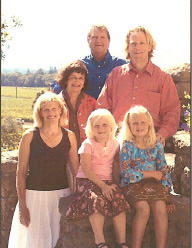 After the repeal of Prohibition, Walter Bundschu’s son, Towle, and Towle’s wife, Mary, continued to farm grapes and sold them under the name of Vineburg Wine Company. Jim Bundschu, Towle’s son, devised a plan to restore the family winery to its previous status. In 1969, he began a four year replanting of Rhinefarm Vineyard to premium varietal grapes. Gundlach Bundschu Winery was resurrected by 1973. Since then, fifth and sixth generation Bundschus have worked together to restore the success of this historic Sonoma Valley property (Fifth generation Jim, upper left, and sixth generation Jeff, upper right, pictured with family.) Gundlach Bundschu was known primarily for their red wines - Merlot, Cabernet, and Zinfandel - which were respectable, but Pinot Noir was an afterthought. A pivotal moment came in 1997, when the winery acquired 140 acres adjacent to their existing vineyard. Jim and son Jeff agreed at this point that they needed to raise their wine quality ambitions as they began the development and integration of this new property. Phil Freese and Zelma Long were hired in 2000 to assist in development of a master transition plan for the vineyard. In 2001, the vineyard and cellar management practices were overhauled. More than 150 acres of the estate have been planted over the last 10 years, including 25 acres of Pommard 5, Dijon 115, 667, and 777 clones of Pinot Noir on the valley floor. Rhinefarm Vineyard now has 320 acres under vine, farmed in more than 50 distinct blocks. Total production at Gundlach Bundschu has been reduced from 75,000 cases to approximately 45,000 cases (25,000-35,000 cases of estate wine and the rest under the winery’s second label, Bearitage). This is part of the new commitment to quality estate wine production and the desire to leave behind wines whose quality no longer meet the winery’s standard. Gundlach Bundschu has partnered with Wilson Daniels to enhance distribution and marketing. Jeff Bundschu has a colorful background and his full story is told on the winery’s website: www.gunbun.com. In 1993, he founded Wine Brats with two friends to promote wine to new wine drinkers ages 21 to 36 (“Xoomers”). There are now 60 chapters nationwide and a book titled Wine Brats Guide to Living has been published. He is also the driving force behind the humorous posters that the winery is known for: 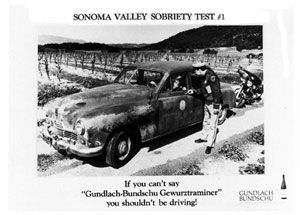 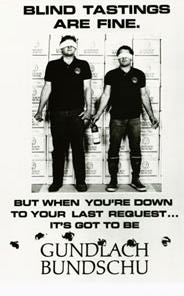 The winemaker at Gundlach Bundschu is Linda Trotta, a Southern Californian of Italian heritage. She attended University of California Davis intending to be a math major, but her travails with calculus led her instead to the department of fermentation science. After graduating, she gained her winemaking experience in Italy and in California at St. Francis and Sebastiani. She joined Gundlach Bundschu and became winemaker in 1990. The Pinot Noir grown on the Rhinefarm Vineyard is located on the lower portion of the vineyard, a section that is across the street from the Carneros appellation border and therefore shares the cooling benefits of the wind and fog from San Pablo Bay. The Huichica clay-loam topsoil is only 22”-30” in depth, beneath which is compacted Carneros Bay sediment that naturally restricts vigor. The climate and soils combine to produce maximum hang time and tiny berries.
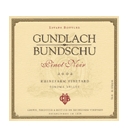 2004 Gundlach Bundschu Rhinefarm Vineyard Sonoma Valley Pinot Noir 14.8% alc., 3,318 cases, $32. The 2004 vintage, the 146th harvest on Rhinefarm, was the earliest on record. Two-thirds of the fruit came from vines planted in 1970 (one of the oldest Pinot Noir vineyards in California) consisting of Wente and Hanzell clonal selections. The other third came from vines planted in 1999 consisting of Dijon 115 and Pommard 5 clones. Winemaking included pre-fermentation cold soak, twice-daily gentle pumpovers, and aging for 11 months in 40% new Tonnellerie Remond oak barrels. · There is noticeable, but not obtrusive, oak influence in this refreshingly crisp Pinot Noir. Scents of cherries and herbs are accompanied by tastes of savory berries, black cherry and clove. Sleek and balanced, the wine finishes clean with fine dusty tannins and uplifting verve.
Gundlach Bundschu is located five minutes south of downtown Sonoma at 2000 Denmark St. The tasting room is open 7 days a week, 11:00 - 4:30. It is built around the original winery structure, with stone walls dating to 1870. A picturesque picnic terrace is adjacent. The winery’s caves can be visited by appointment. The phone is 707-938-5277 and the website is www.gunbun.com.
SpittingGeri Tashjian of The Burgundy Wine Company in New York City, a knowledgeable source for Burgundy and Burgundy tasting events wrote the following in a recent newsletter (info@burgundywinecompany.com to join the e-mail newsletter list): “I have never been a champion spitter, in fact, it took me a long time to get comfortable with the practice. I would dribble, drool and dither around the spit bucket wishing for invisibility. I was happy when I didn’t spit on my shoes. I was so awkward, a friend once tried to teach me how to spit. On reflection, that was silly. There wasn’t much to learn - I just had to get the wine out of my mouth. I’ve noticed I am not alone and alot of people find it awkward to spit. It’s not just the act of spitting, it’s also the “how” of spitting. And the “how” is quite simple. You don’t need a special technique, great aim or ability to shoot for distance. Just position yourself close to the bucket - pucker and spit. Believe me, no one will be critiquing your style, because who really wants to watch someone spit.” I can add that you might consider practicing at home with water.
Burgundy Boot CampThe Bouilland Symposium is a 10-year-old training program for wealthy Wall Street wine enthusiasts who are interested in purchasing a Burgundy vineyard or domaine. Each boot camp session is limited to 10 students for each of its twice-a-year gatherings, and costs $8,350. Becky Wasserman founded the symposium in 1996 and all of the 150 Burgundy investors that have attended have aspired to own a domaine. Wasserman moved to Burgundy from New York in 1968 to sell oak barrels (Tonnellerie Francois Feres) from her farmhouse in Bouilland. In 1979, she formed Le Serbet Sari as a wine brokerage to represent domaine owners. She was the first American wine broker to live and work in Burgundy and one of the first to deal primarily with grower-producers who bottled their own wine (estate bottlers). At the time, very few producers in Burgundy shipped their wine beyond France. Today she has seven employees at her office in the former chancellery of the Duke of Burgundy in Beaune and exports Burgundy from 130 domaines. Francois Freres has become one of the largest single tonnelleries in Burgundy. Investing in a domaine is expensive and very risky. As reported in the International Herald Tribune (September 27, 2006), none of the potential buyers do it for the money. A return of 4 percent is considered good, with most Burgundy domaines turning between a 2 and 3 percent profit. It is the lifestyle and the lure of investing in 2,000 years of Cote d’Or winemaking that appeals to investors. It costs up to five generations to pay off a grand cru investment. Francois-Henri Pinault, CEO of Pinault-Printemps-Redoute, and owner of Chateau Latour in Bordeaux, paid $22.3 million for control of 6 hectares of Domaine Engel vines in Vosne-Romanee that produces Clos Vougeot, Echezeaux and Grand Echezeaux. |